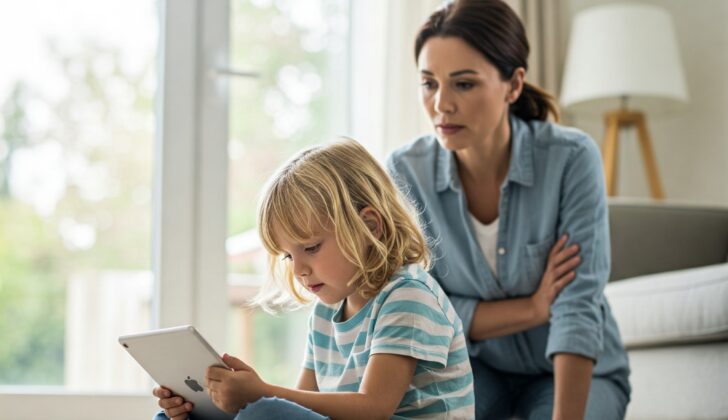How Too Much Screen Time Can Affect Your Child’s Emotions and Behavior
In today’s digital age, screens are everywhere—on our walls, in our pockets, and often in our children’s hands. While technology offers exciting educational opportunities and entertainment, more studies are showing that too much screen time can affect a child’s socioemotional development.
From increased anxiety and depression to hyperactivity and aggression, the risks of excessive screen exposure are real. But that doesn’t mean screens are all bad. The key is balance.
In this article, we’ll explore:
-
How screen time impacts children’s emotions and behavior
-
What current research says
-
Signs of unhealthy screen habits
-
Simple strategies to create healthier boundaries at home
What Is Socioemotional Development?
Socioemotional development refers to how children understand and manage emotions, form relationships, and navigate social situations. It’s a critical part of growing up, laying the foundation for mental health, communication skills, and empathy.
When this development is disrupted, children may:
-
Struggle to form friendships
-
Have trouble handling frustration or disappointment
-
Show more behavioral challenges
-
Feel anxious or withdrawn
The Risks of Excessive Screen Time
1. Increased Risk of Anxiety and Depression
Studies show that children who spend large amounts of time on screens—especially passively watching videos or scrolling—are more likely to report symptoms of depression, anxiety, and low self-esteem.
Why? Screen time can:
-
Disrupt sleep patterns
-
Reduce physical activity
-
Limit real-life social interaction
-
Expose children to unrealistic social comparisons or distressing content
2. Hyperactivity and Attention Problems
Fast-paced screen content, especially from apps, games, and cartoons, can overstimulate the brain. Over time, this can affect a child’s attention span and increase hyperactive behaviors, especially in younger kids.
Children who use screens excessively may:
-
Have trouble focusing in class
-
Struggle to stay still during quiet activities
-
Seem “wired” or unable to calm down
3. Increased Aggression and Impulsivity
Exposure to violent or overly stimulating content can normalize aggressive behavior. Children may have a harder time self-regulating emotions or understanding the impact of their actions.
Are Screens Always Harmful?
Not necessarily. Screen time can have educational benefits when used in moderation and under supervision. Interactive games that promote problem-solving, shows that teach language, and video calls with family can support learning and connection.
The problem lies in:
-
Unrestricted use
-
Passive scrolling or binge-watching
-
Lack of supervision or content filtering
-
Using screens to soothe every emotion or tantrum
When screen time replaces real-life interaction, play, or rest, that’s when problems begin to show.
Signs Your Child May Be Getting Too Much Screen Time
-
Meltdowns or anger when asked to stop
-
Constantly asking for screen time or sneaking it
-
Trouble sleeping or falling asleep
-
Withdrawn from family activities
-
Frequent irritability, restlessness, or poor focus
-
Less interest in play, reading, or physical activity
If you’re seeing several of these signs, it might be time to reassess your family’s screen habits.
How Much Screen Time Is OK?
The American Academy of Pediatrics (AAP) recommends:
-
Under 18 months: Avoid screens altogether (except for video calls).
-
18–24 months: Limited, high-quality content watched with an adult.
-
2–5 years: No more than 1 hour per day of high-quality programming.
-
6+ years: Set consistent limits, ensure screen time doesn’t interfere with sleep, exercise, or real-world interaction.
Tips for Creating Healthy Screen Habits
Set a Screen Time Schedule
Decide ahead of time when screens are allowed (e.g., after homework or before dinner) and stick to it. Use visual timers for younger children.
Create Screen-Free Zones
Make bedrooms, dinner tables, and family events screen-free to encourage presence and bonding.
Watch Together
Co-viewing allows you to guide your child’s learning, explain tricky content, and model healthy reactions.
Prioritize Face-to-Face Time
Talk, read, play, and cuddle with your child daily—these moments are critical for emotional growth.
Offer Alternatives
Bored kids often default to screens. Offer alternatives like art, outdoor play, music, or imaginative games.
Use Parental Controls
Use built-in tools or apps to filter content, limit screen time, and monitor usage when needed.
Helping Kids Self-Regulate Without Screens
One challenge for parents is when screens become a soothing tool for every tantrum, car ride, or meal. While this works short-term, it limits kids’ ability to learn self-regulation.
Try these instead:
-
Deep breathing or stretching
-
Sensory toys or fidgets
-
Drawing or scribbling feelings
-
Naming emotions with words: “You’re feeling frustrated because it’s hard to wait.”
Teach kids that feelings are OK—and that screens aren’t the only way to feel better.
Final Thoughts
Screens aren’t the enemy—but unlimited, unsupervised screen time can interfere with your child’s emotional health and social development. The goal isn’t zero screen time. The goal is mindful screen time that fits into a balanced, connected family life.
With simple routines, clear boundaries, and lots of loving interaction, your child can enjoy the best of both the digital and real world.
Explore More:












